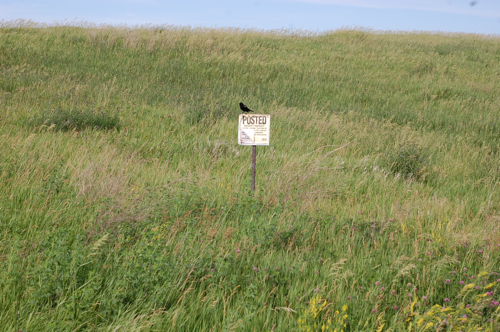Horned Lark Display
 I've had some work taking me to southern Minnesota the last few weeks where I spend the day out in a field with red-winged blackbirds and a few other prairie species.
I've had some work taking me to southern Minnesota the last few weeks where I spend the day out in a field with red-winged blackbirds and a few other prairie species.

It's not a bad way to spend the day. My biggest challenge has been the black flies--a pest I previously only associated with the north woods and not the open fields of southern Minnesota. I'm not a big fan of insect repellent that is so strong that it should in no way come into contact with my skin and I shouldn't wear my clothes for a few hours after it has been sprayed on it. Yet, I'm even less of a fan of biting insects that fly into my ear canal or up my nose, so I tried using permethrin.

And it appears to be doing the trick. If it's windy, the black flies stay way--too small to fly in the wind I suppose. However, when the wind stops, I appear to have an invisible barrier the flies are not willing to cross. This is the view right above my head, the flies hover like a tiny buzzing entourage as I walk the fields. Black flies are attracted to carbon dioxide, so with every exhalation the females know I am a blood source but the permethrin prevents them from venturing any closer and biting me. It's a relief, but an uneasy one. I'm buying instant gratification from bug bites and bugs being in places on my body they do not belong, but what long term effects will a heavy duty repellent like permethrin bring?

Horned larks are another constant companion in the fields. Horned larks are a bird that many people have seen, but not realized it. You drive down a farm field and a small brownish gray bird flushes--chances are that it's a horned lark. They are easy to id from other farm field species by the black lines visible on either side of the tail as they fly away. They are a cute little bird to see in the fields but not everyone has a chance to really enjoy them up close. I've spent some agonizing moments leading field trips in the rain on the prairie trying to get someone their lifer look through a spotting scope of one of these birds and at those moments I wish I could teleport us to the middle of a farm field on a sunny day where if you wait patiently for about 10 minutes, one will scurry by.

I set a little goal for myself to try and get a photo of a horned lark in the middle of his territory display. They fly high, practically hanging in the air while singing their little tinkling whistle. Here's a sample of the song at Xeno-Canto. However, trying to capture them in a photo while they are singing in the sky is no easy task as you can see from the above image.

Quite of few of the photos ended up blurry or with only parts of lark in it as opposed to the whole bird in focus. Part of the challenge is to find them in my spotting scope in the sky. If the skies are clear, it's an exercise in futility. However, if there are clouds--I stand a chance because I can use the cloud shapes as a guide to find the hovering lark.

But after about 200 clicks on the camera, I did have one or two that were in focus--score! What a delicately marked bird--I love the contrast of the dark marks on the face accented by the dark tail. Periodically, other males would work into a male's territory. At one point, 3 males were duking it out.

Look! He's danling his feet like he's a little raptor! Note how erect the little horn feathers are--channeling a bit of great horned owl there. When the 3 males discovered each other in the air the singing became more urgent. Although, it's hard to take the angry trickling whistles seriously as any sort of threat. But two of the males swerved towards each other and frantically began to flutter and "claw" their little feet at each other. They dropped like a stone and continued the fight on ground. The two intruders took their fight elsewhere.

After the skirmish, the lone male resumed is aerial display. Not a bad song to have as your office music for the day.
